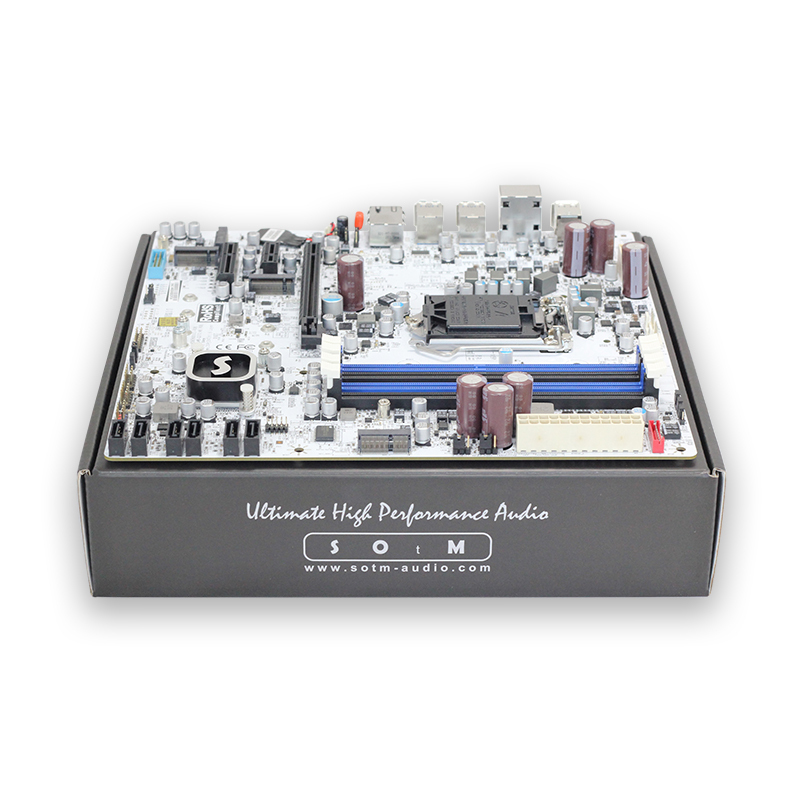Wow, what a week for product announcements. First HQPlayer integrates Qobuz, then VOX integrates Qobuz, then AURALiC integrates Amazon Music Unlimited. Now, SOtM launches its own motherboard named sMB-Q370. For many audiophiles this will be beyond geeky, but for many others this is really a neat product. Building a motherboard is a huge undertaking to say the least.
I can't wait to see this one in the wild and to start getting feedback from the Audiophile Style community as more people integrate this motherboard into their systems. Very cool indeed.
MSRP $500
From SOtM:
The sMB-Q370 is a high-performance computer motherboard specially designed for audio. Since this product is equipped with an Intel series CPU, it can replace all commonly used computer motherboards.
There is a variety of motherboards and network audio players on the market that meet the high-performance specification and certainly there are a variety of choices too, but the products using these general motherboards are designed simply for fast operation to accomplish processing of large-capacity music files or converting music files to high sampling rates such as DSD. You won’t be able to avoid the limitations of the sound quality, which will be revealed clearly if you use such products as audio players.
Even if the sCLK-EX, tX-USBexp, sNI-1G and others are installed and used on these general motherboards to improve sound quality, the source itself cannot be compared with that of a system using the audio grade motherboard, sMB-Q370.
So, using the sMB-Q370 means starting a new beginning to your listening experience.
You would simply get clear improvements in every aspect of the music including the background, texture, tension, resolution, and location in space of the music with the sMB-Q370 designed exclusively for audio. If you close your eyes and listen to the music, you will feel as if it is the beginning of a new world with the subtle reverberation of instruments resonating in the dark.
In order to implement audio performance that exceeds the limitations of general motherboards in the existing market, the sMB-Q370 has applied a large number of audio parts that have been verified by being used in SOtM products for a long time and is designed to minimize the impact on each element inside the board to reduce noise as much as possible. Although this explanation may seem very simple, it can be said that it is the culmination of the many technologies that SOtM has implemented so far. The very deep and in-depth accumulation of technologies has made this possible.
In addition, the sMB-Q370 has all the features of an existing PC, so everything that was possible with a regular PC can be replaced to the sMB-Q370. A high-performance graphics card, various types of PCI express add-on cards, M.2 NVMe SSD, M.2 Wifi module, M.2 Ethernet port, SATA storage device, etc. can be installed to expand the performance and use of the PC. With this combination of scalability and low noise performance, the sMB-Q370 has no limits in the fields where it is difficult to use general boards, such as mixing and mastering computers for studios and medical devices that require 3D functions.
If you’ve been looking for a high-performance motherboard that has the features you need and meets the best sound quality and performance ever, we can assure you that there’s no need to worry anymore. The best performance, sound quality and expandability, all of these can be realized with the motherboard designed exclusively for audio, sMB-Q370.
Now, it is the time to make the choice that will bring your system to its peak with the sMB-Q370.

















Recommended Comments
Create an account or sign in to comment
You need to be a member in order to leave a comment
Create an account
Sign up for a new account in our community. It's easy!
Register a new accountSign in
Already have an account? Sign in here.
Sign In Now